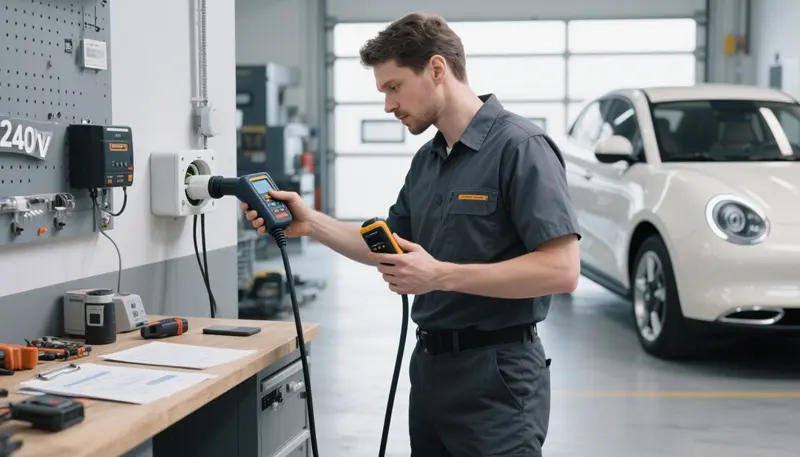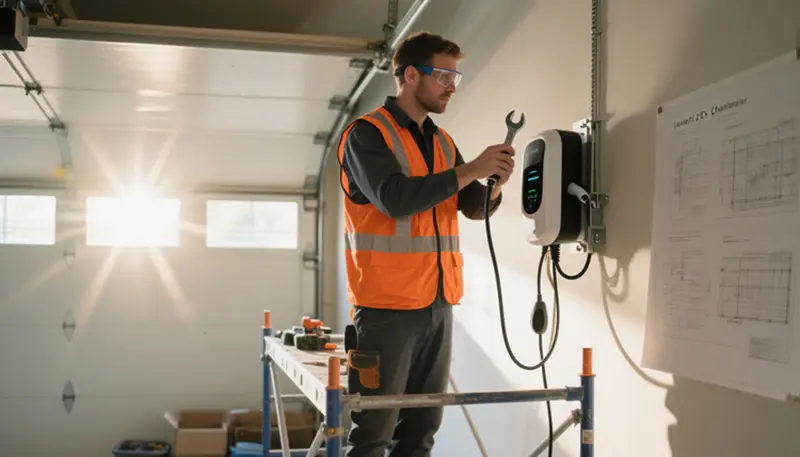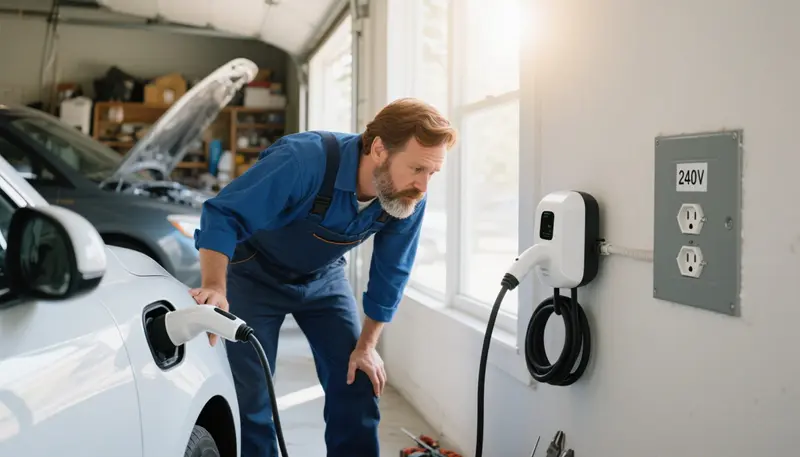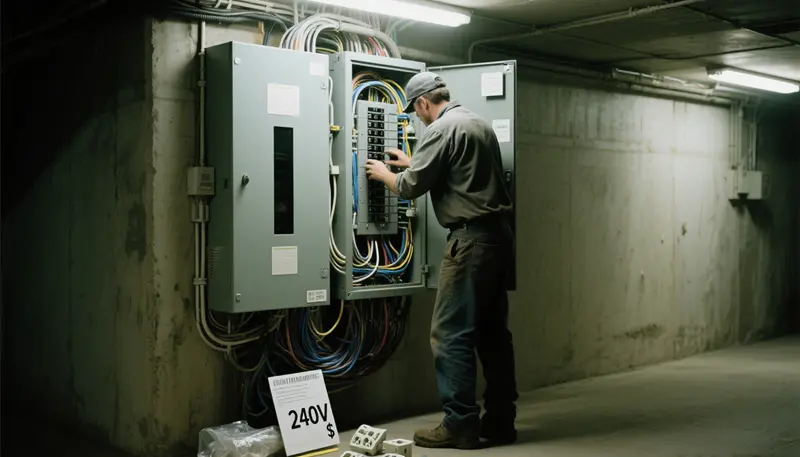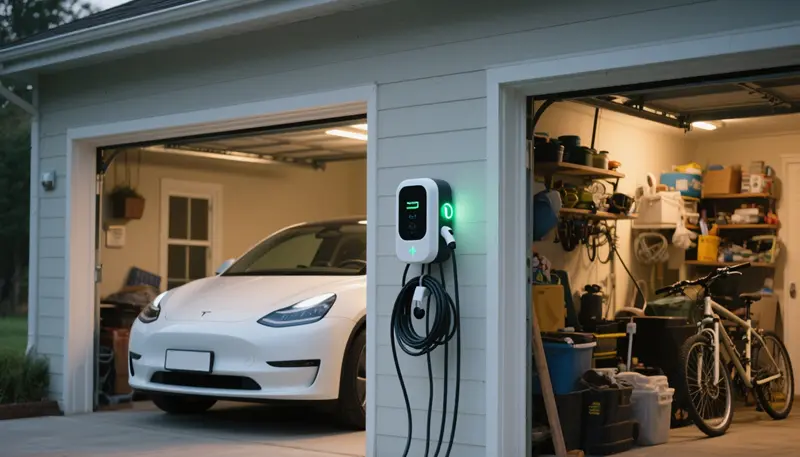Blog
Cost to Install 240V Outlet for Electric Car: A Complete Guide
Introduction to 240V Outlet Installation for Electric Cars
As electric vehicles (EVs) become increasingly popular in the U.S. and Europe, the demand for efficient home charging solutions is on the rise. A 240V outlet is the backbone of Level 2 charging, offering significantly faster charging speeds than standard 120V outlets, making it a must-have for EV owners, including those driving Teslas or other electric models. But what is the cost to install a 240V outlet for an electric car? Is it worth the investment, and how do you go about it? This comprehensive guide answers these questions, providing a detailed breakdown of costs, installation steps, and considerations for installing a 240V outlet for an EV charger or Tesla.
This article explores the cost to install a 240V outlet for an electric car, how to install a 240-volt outlet, and key factors that influence pricing. Whether you’re a new EV owner or upgrading your charging setup, we’ll guide you through every aspect of 240V outlet installation to ensure a safe, cost-effective, and efficient charging experience.
Why Install a 240V Outlet for Your Electric Car?
The Rise of Electric Vehicles
With EV sales projected to reach 18 million globally by 2030 (International Energy Agency, 2025), owning an electric car is no longer a niche choice. From Tesla’s Model 3 to Nissan’s Leaf and Rivian’s R1T, EVs are mainstream, and home charging is a critical part of the ownership experience. A 240V outlet enables Level 2 charging, delivering 20-50 miles of range per hour, compared to just 3-5 miles with a Level 1 (120V) outlet.
Benefits of a 240V Outlet for EV Charging
- Faster Charging: A 240V outlet for an EV charger can charge your vehicle 5-10 times faster than a 120V outlet, ideal for daily commutes or long trips.
- Convenience: Charge overnight and wake up to a fully charged EV, eliminating the need for frequent public charging.
- Cost Savings: Home charging with a 240V outlet is cheaper than public stations, especially with off-peak electricity rates.
- Versatility: Supports most EVs, including Teslas, with standard outlets like NEMA 14-50 or 6-50.
- Property Value: Installing a 240V outlet for an electric car can increase your home’s appeal, especially in EV-heavy markets like California or Norway.
Whether you’re considering the cost to install a 240V outlet for a Tesla or another EV, a Level 2 charger (e.g.,👉 FlagTools Home EV Charger) powered by a 240V outlet is a game-changer for convenience and efficiency.
Cost to Install a 240V Outlet for Electric Car: A Detailed Breakdown
The cost to install a 240V outlet for an electric car varies based on several factors, including your home’s electrical system, the outlet’s location, and local labor rates. Below is a comprehensive cost analysis:
1. Equipment Costs
- Outlet and Breaker: A 240V outlet (e.g., NEMA 14-50 or 6-50) costs $10-$50. A compatible 40-50 amp breaker costs $20-$50.
- Wiring and Conduit: Heavy-gauge wiring (e.g., 6 AWG copper) and conduit for safety typically cost $50-$100, depending on distance.
- Mounting Hardware: Outlet boxes and mounting materials add $10-$50.
Total Equipment Cost: $50-$200.
2.Labor Costs
- Electrician Fees: Hiring a licensed electrician for 240V outlet installation typically costs $300-$1,500. Rates vary by region:
- U.S.: $50-$150 per hour (urban areas like California or New York are higher).
- Europe: €40-€100 per hour (higher in countries like Germany or the UK).
- Installation Time: Simple installations (e.g., in a garage near the panel) take 2-4 hours. Complex setups (e.g., outdoor or distant locations) may take 6-8 hours.
Total Labor Cost: $300-$1,500.
3. Electrical Upgrades
- Panel Upgrade: If your home’s electrical panel (e.g., 100 amps) lacks capacity for a 40-50 amp circuit, upgrading to 200 amps costs $1,000-$3,000.
- Subpanel Installation: For homes with limited main panel capacity, a subpanel costs $500-$1,500.
- Utility Upgrades: Rare for 240V outlets, but upgrading a transformer or service line can add $2,000-$5,000.
Total Upgrade Cost: $0-$3,000 (if needed).
4. Permits and Fees
- Permits: Most municipalities require permits for 240V outlet installation, costing $50-$200.
- Inspection Fees: Post-installation inspections may add $50-$150.
Total Permit Cost: $50-$200.
Total Cost Range
- Basic Installation: $400-$800 (outlet near panel, no upgrades).
- Average Installation: $800-$2,000 (moderate wiring, standard labor).
- Complex Installation: $2,000-$5,000 (panel upgrades, long wiring runs).
Regional Cost Variations
- U.S.: Costs are higher in urban areas (e.g., San Francisco: $1,000-$3,000) and lower in rural regions (e.g., Midwest: $500-$1,500).
- Europe: Higher labor rates in countries like Germany (€1,000-€2,500) and lower in Eastern Europe (€500-€1,500).
The cost to install a 240V outlet for an EV charger or Tesla typically ranges from $400-$2,000 for most homeowners, with outliers for complex setups.
How to Install a 240 Volt Outlet for Electric Car
Installing a 240V outlet for an electric car requires professional expertise to ensure safety and compliance. Below are the key steps for how to install a 240 volt outlet for electric car charging:
Assess Your Electrical System
- Panel Capacity: A licensed electrician will check if your panel (typically 100-200 amps) can support a 40-50 amp circuit for a 240V outlet for an EV charger.
- Load Calculation: Ensure the new circuit won’t overload your system, especially if you have high-power appliances (e.g., HVAC, dryer).
- Location Planning: Choose an outlet location (e.g., garage, driveway) close to the panel to minimize wiring costs.
Choose the Right Outlet
- NEMA 14-50: Common for Tesla and other EVs, with four prongs (hot, hot, neutral, ground). Costs $10-$30.
- NEMA 6-50: Three prongs (hot, hot, ground), used for some EV chargers. Costs $10-$25.
- Compatibility: Confirm the outlet matches your EV charger’s plug (e.g., Tesla Mobile Connector uses NEMA 14-50).
Hire a Licensed Electrician
- Why Professional Installation? A 240V outlet for an electric car involves high-voltage wiring, posing risks of fire or electrocution if installed incorrectly. DIY is strongly discouraged.
- Finding an Electrician: Search for “electricians near me” or use manufacturer directories (e.g., Tesla’s certified installers). Check credentials, reviews, and experience with 240V outlet installation.
Obtain Permits
- Most jurisdictions require permits for 240V outlet installation to comply with the National Electrical Code (NEC) Article 625. (Learn more about 👉“How to Apply for a Permit to Install an EV Charger”)
- Your electrician will submit plans and coordinate inspections, ensuring the outlet meets safety standards.
Installation Process
- Wiring: Run 6 AWG copper or 4 AWG aluminum wiring from the panel to the outlet location, using conduit for outdoor or exposed runs.
- Breaker Installation: Install a 40-50 amp double-pole breaker in the panel.
- Outlet Mounting: Secure the outlet in a weatherproof box (e.g., NEMA 3R for outdoor use).
- Testing: Verify the outlet delivers 240 volts and functions correctly with your EV charger.
Final Inspection
- A local inspector will check the installation for code compliance, ensuring safety and proper grounding.
- Once approved, connect your EV charger and test charging performance.
The entire process typically takes 2-8 hours, depending on complexity. For Tesla owners, the cost to install a 240V outlet for a Tesla follows the same process, with the NEMA 14-50 being the most common outlet type.
Factors Influencing the Cost to Install a 240V Outlet for Electric Car
Several factors impact the cost to install a 240V outlet for an electric car:
1. Electrical Panel Capacity
- Older Homes: Panels with 100 amps or less may require upgrading to 200 amps to support a 240V outlet for an EV charger, adding $1,000-$3,000.
- Modern Homes: 200-amp panels typically have sufficient capacity, avoiding upgrade costs.
2. Outlet Location
- Near Panel: Installing in a garage or basement near the panel reduces wiring costs ($400-$800 total).
- Distant or Outdoor: Long wiring runs or outdoor installations (e.g., driveway) increase costs due to conduit and labor ($1,000-$2,500).
3. Regional Labor Rates
- U.S.: Urban areas like Los Angeles or New York have higher rates ($100-$150/hour) than rural areas ($50-$80/hour).
- Europe: Countries like Germany and the UK have higher rates (€80-€120/hour) than Eastern Europe (€40-€60/hour).
4. Electrical Upgrades
- Subpanel: If the main panel is full, a subpanel costs $500-$1,500.
- Service Upgrade: Upgrading from 100 to 200 amps or adding a new service line can cost $2,000-$5,000.
5. Permitting and Code Requirements
- Some municipalities have stricter codes, increasing permit costs or requiring additional safety features (e.g., GFCI breakers, $50-$100).
Cost-Saving Tips
- Choose a Nearby Location: Install the outlet close to the panel to minimize wiring.
- Compare Quotes: Get estimates from 3-5 electricians to find the best price for 240V outlet installation.
- Leverage Incentives: Check for rebates or tax credits to offset the cost to install a 240V outlet for an EV charger.
- Future-Proof: Install a 50-amp circuit to support higher-power chargers or future EVs.
Government Incentives and Long-Term Savings
Incentives to Reduce Costs
Installing a 240V outlet for an electric car may qualify for financial incentives, reducing the upfront cost:
- United States:
- Federal Tax Credit: The Alternative Fuel Vehicle Refueling Property Credit offers up to 30% of costs (capped at $1,000 for residential installations, as of 2025).
- State Rebates: Programs like California’s Clean Vehicle Rebate Project or New York’s ChargeNY offer $500-$1,000 for 240V outlet installation.
- Utility Rebates: Companies like PG&E or ConEd provide rebates or discounted off-peak rates.
- Europe:
- UK: The Electric Vehicle Homecharge Scheme offers up to £350 for charger and outlet installations (subject to eligibility).
- Germany: KfW grants provide up to €900 per charging point.
- EU-Wide: The Connecting Europe Facility (CEF) supports residential charging infrastructure in some cases.
How to Apply: Work with your electrician or check government websites (e.g., energy.gov, gov.uk) for application details.
Long-Term Savings
- Electricity Costs: Charging at home with a 240V outlet for an EV charger is cheaper than public stations, especially with time-of-use (TOU) rates (e.g., $0.10-$0.20/kWh off-peak vs. $0.30-$0.50/kWh at public chargers).
- Avoiding Public Charging: Save $100-$500 annually by charging at home instead of public stations.
- Battery Efficiency: Level 2 charging is gentler on EV batteries than DC fast charging, potentially extending battery life.
- Property Value: A 240V outlet for an electric car can increase home resale value by 1-3% in EV-heavy markets (e.g., California, Norway).
By combining incentives and long-term savings, the cost to install a 240V outlet for an electric car can be recouped in 1-3 years for frequent EV users.
Frequently Asked Questions (FAQ)
Q: What is the cost to install a 240V outlet for an electric car?
A: The cost to install a 240V outlet for an electric car ranges from $400-$2,000, including equipment ($50-$200), labor ($300-$1,500), and permits ($50-$200). Complex setups with panel upgrades can reach $2,000-$5,000.
Q: How long does it take to install a 240V outlet for an EV charger?
A: Installation typically takes 2-8 hours, depending on the outlet’s location and electrical complexity. Panel upgrades may extend the timeline to 1-2 days.
Q: Do I need a specific outlet for a Tesla?
A: The cost to install a 240V outlet for a Tesla follows the same range ($400-$2,000). Tesla recommends a NEMA 14-50 outlet for its Mobile Connector, but other EVs may use NEMA 6-50 or hardwired chargers.
Q: Can I install a 240V outlet for an electric car myself?
A: DIY installation is not recommended due to high-voltage risks and code requirements. Hire a licensed electrician to ensure safety and compliance for how to install a 240 volt outlet for electric car.
Q: Do I need to upgrade my electrical panel for a 240V outlet?
A: If your panel is 100 amps or less, you may need a $1,000-$3,000 upgrade to support a 240V outlet for an EV charger. A 200-amp panel is usually sufficient.
Q: Are there incentives for the cost to install a 240V outlet for an EV charger?
A: Yes, U.S. federal tax credits (up to $1,000) and state rebates (e.g., $500-$1,000 in California) can reduce the cost to install a 240V outlet for an electric car. European programs like the UK’s EVHS offer similar support.
Conclusion: Invest in a 240V Outlet for Your Electric Car
Installing a 240V outlet for an electric car is a smart investment for EV owners seeking faster, more convenient charging. With costs ranging from $400-$2,000 (and up to $5,000 for complex setups), a 240V outlet for an EV charger or Tesla delivers significant benefits: faster charging, cost savings, and increased property value. By following the steps outlined—assessing your electrical system, hiring a licensed electrician, and leveraging incentives—you can ensure a safe and efficient 240V outlet installation.
Call to Action: Ready to power up your EV charging? Contact a certified electrician today to get quotes for the cost to install a 240V outlet for an electric car. Check local incentives to save on your 240V outlet for an EV charger and start enjoying faster, more convenient charging!


